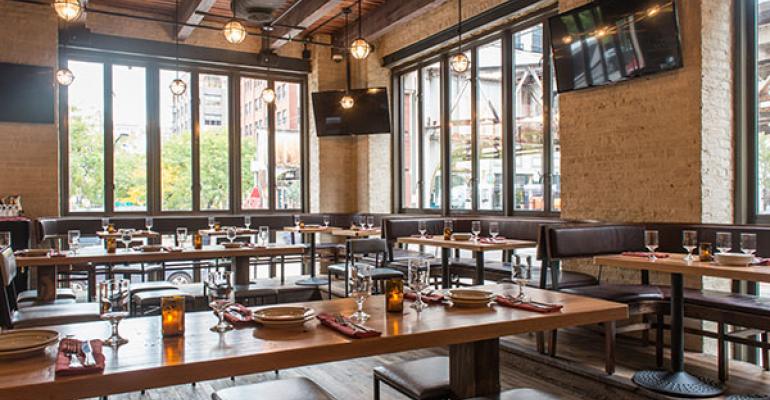It’s clear that Millennials are eating and drinking differently than their parents. They want more authentic experiences and are open to sharing those experiences with other diners. They want a restaurant’s design to reflect its cuisine, and ultimately they want the restaurant to be true to what it’s offering.
So restaurant designers and architects, armed with that information, are challenged to meet diner expectations while also satisfying the vision of the restaurant owner. All the while balancing aesthetics and functionality so the restaurant can run efficiently. It’s a lot to manage.
Celano Design Studio recently worked with Mercadito Hospitality and beverage-consulting firm Tippling Bros. to create Tippling Hall, a Chicago-area beer hall and dining spot offering comfort food and late-night dining. And Kraemer Design Group recently completed the architectural and interior design for a new bar concept, the Beer Grotto, which has one location open and two more under development.
Celano founder and principal Vincent Celano and Bob Kraemer, principal of Kraemer Design Group, talked about the challenges to designing restaurants today, as well as strategies to meet evolving consumer demands.
RH: When designing a new restaurant, what resource materials or background information come in handy?
 Kraemer: The trends come to us a couple of ways: just attending restaurants in general to get the real-life experiences, and I rely on a lot on classic industry magazines and newsletters. The interior design team uses the manufacturer representatives and their resources a lot. In the end, we put all of that behind us in a sense because we believe meeting with the client and understanding what their vision is is most important. We almost always find they are ahead of us in the trends but they can’t always put what they’re looking for in words. Restaurateurs are inherently entrepreneurs and for the most part they’ve got a vision.
Kraemer: The trends come to us a couple of ways: just attending restaurants in general to get the real-life experiences, and I rely on a lot on classic industry magazines and newsletters. The interior design team uses the manufacturer representatives and their resources a lot. In the end, we put all of that behind us in a sense because we believe meeting with the client and understanding what their vision is is most important. We almost always find they are ahead of us in the trends but they can’t always put what they’re looking for in words. Restaurateurs are inherently entrepreneurs and for the most part they’ve got a vision.
 Celano: Today we have access to an overload of information and we are very careful to not get lost in the latest trend or get stuck with lots of ideas that are not great. One great idea is always better than 10 just good ideas. As far as the direction, on every project we spend time collecting the ingredients that bring relevance to the concept: the chef, beverage director, branding etc. It’s very project-specific.
Celano: Today we have access to an overload of information and we are very careful to not get lost in the latest trend or get stuck with lots of ideas that are not great. One great idea is always better than 10 just good ideas. As far as the direction, on every project we spend time collecting the ingredients that bring relevance to the concept: the chef, beverage director, branding etc. It’s very project-specific.
RH: How important is collaboration among other departments of the restaurant and which key parties need to get involved in the design?
Kraemer: Too many cooks in the kitchen is clearly an issue you have to resolve. We tend to break down meetings into several groups. The first is with key ownership—the true client. That conversation is usually private and we’re trying to hear their vision. Then we take it into a working session with key department heads using that information. This is where we really start to say, “Here’s the vision, how can we best work with that?” It takes two steps: getting their feedback early on and then, once we have a design, presenting the design and getting them to buy into it.
Celano: We never approach the design process like we have one cook, simply because it’s not ready to go in the oven or be served to the guest yet. Our process is very collaborative. We pull the team together from the owner’s side and our studio, which is very important. We share ideas and experiences—nothing too specific yet on the design. Then it’s our job to pull it together and make sure it works and meets expectations.
Identifying popular design trends
RH: Diners today are said to be seeking an authentic experience. What does that mean in terms of design and how do you know if you’ve achieved it?
Kraemer: “Authentic” seems to be a buzzword and, on a personal level, I don’t know what that truly means. Having grown up in Mexico and enjoying Mexican food, a restaurant with a bad Mexican motif doesn’t represent authentic to me. Authentic, to me, means the experience, both aesthetically and culinarily, is all true to itself. The aesthetic needs to match the cuisine and the service style. There are restaurants that want to serve farm-to-table, but then you find out their whole facility was not designed in a sustainable manner. Today’s customers are much more informed and will see through that.
Celano: To achieve this, as a designer you must listen more and understand what the client’s expectations are. As a society we evolve, so our experience and the spaces we interact in also evolve. Keeping up with how people interact is very important. Also having an architectural background stay true to the material is important. We don’t fake it—it must be real.
RH: How much do the menu and cuisine impact a restaurant’s design?
Kraemer: There’s the cuisine and then there’s the physical menu. I ultimately believe the menu, the thing the person picks up, is the more important of the two. We always try to tell our customer the menu has to be an extension of the design—it’s the correlation between the space and the food. As architects and designers, it’s critical we know what the food is and if there’s a story behind it. Those menus that have a little blip about the restaurant’s story on the back page are always entertaining, but we need to extend that throughout the whole space.
Celano: Starting with a menu is great because then we can design an experience that works with and complements the food. They both must work well together—inspiration and influences come from both, but sometimes we start with a concept that then evolves and influences the menu. Ultimately, it really depends on who is the client or chef.
RH: Can you identify some current design trends that are very popular?
Kraemer: For a long time, the idea of stained concrete was popular either because owners thought it was inexpensive or great for operations. That has gone its way—it’s kind of “been there, done that.” Now what you’re seeing as a design trend is luxury vinyl tile (LVT) with a wood and stone look. We definitely see that in the midscale market because it’s bulletproof. Another trend is to use repurposed materials, even beyond reclaimed wood. From a functional standpoint, there’s the idea of the community table—you’re going to see more introduction of that in the restaurant. The Millennial generation likes that. Restaurateurs love it because it’s a constant churn. We’ve been trying to design that more into properties. We’re also starting to see more correlation with craft beer and how the beers are served, beyond just a plate, how the plating can be tied in with the architecture.
Celano: Bringing the food experience or the making of the food up front as part of the guest experience—open kitchens, raw bars, charcuterie, etc. And the same with the beverage side—whiskey bars, wine bars, etc.





